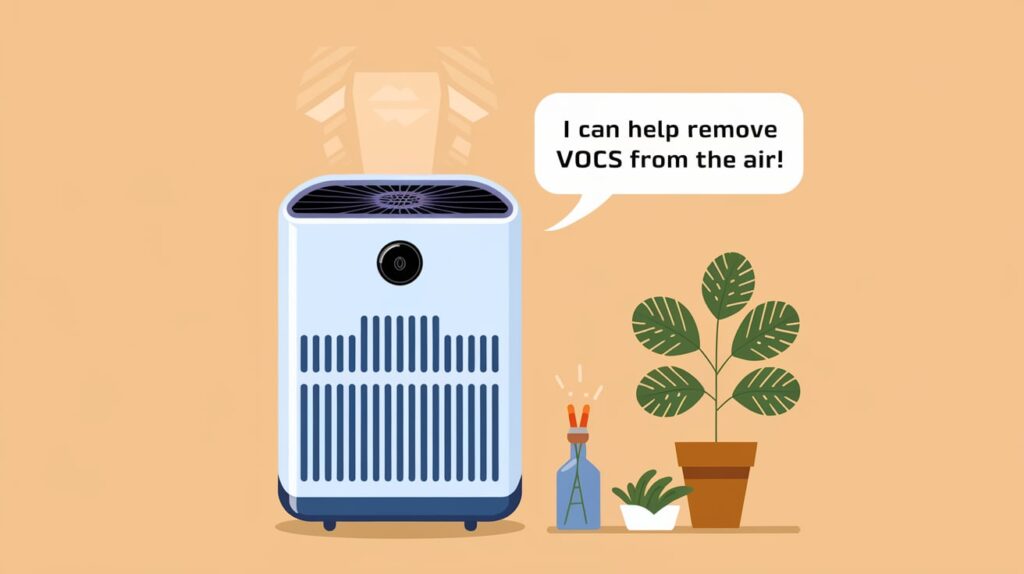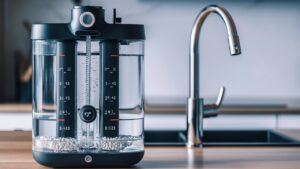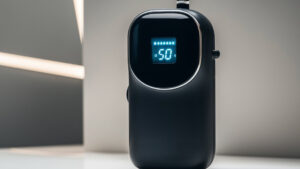Are you worried about the air quality in your home? You might have heard about volatile organic compounds, or VOCs, and wonder how they affect your health.
VOCs are chemicals found in everyday products like paints, cleaning supplies, and even furniture. They can impact your well-being, causing headaches, dizziness, and more serious health issues over time. But here’s the good news: you might already have a tool to combat these invisible threats—an air purifier.
You might ask yourself, “Do air purifiers really help with VOCs? ” You’re not alone in this curiosity. Understanding the effectiveness of air purifiers can empower you to make informed decisions for your living space. Imagine breathing cleaner, fresher air and feeling at ease knowing you’re protecting yourself and your loved ones. Keep reading to discover how air purifiers might be the solution to reducing VOCs and enhancing your home environment.
Air Purifiers: Basic Functionality
Air purifiers work to clean the air in indoor spaces. They help remove pollutants and allergens. This includes dust, pollen, and smoke. Many also target volatile organic compounds (VOCs). VOCs are harmful chemicals found in many household products. These chemicals can affect health and air quality. Understanding how air purifiers function is crucial for effective use.
Types Of Air Purifiers
There are several types of air purifiers available. HEPA filters are popular for trapping particles. Activated carbon filters are also common. They absorb odors and gases, including VOCs. UV purifiers use ultraviolet light to kill germs and bacteria. Ionizers release charged ions that attract pollutants. Each type has unique benefits and limitations.
Mechanisms Of Filtration
Filtration mechanisms vary among air purifiers. HEPA filters capture small particles like dust and pollen. They are effective for allergens. Activated carbon filters target gases and odors. They can help reduce VOCs in the air. UV purifiers neutralize bacteria and viruses. This helps improve indoor air quality. Ionizers use charged ions to clean the air. They cause pollutants to settle out of the air.

Understanding Vocs
Volatile Organic Compounds, or VOCs, are chemicals in the air. They come from many products we use daily. Understanding VOCs is vital for maintaining healthy indoor air. Knowing their sources and effects can help in reducing exposure.
Sources Of Vocs
VOCs come from various household items. Paints and varnishes release VOCs as they dry. Cleaning products often contain these chemicals. Carpets and furniture can emit VOCs too. Even scented candles and air fresheners add VOCs to the air. Many items release VOCs without us realizing it.
Health Risks Associated With Vocs
Breathing VOCs can affect health. Short-term exposure may lead to headaches and dizziness. Long-term exposure can cause respiratory problems. Some VOCs are linked to serious illnesses. Children and the elderly are more vulnerable. Knowing the risks is crucial for safe living.
Air Purifiers And Voc Removal
When you think about the air you breathe at home, you might wonder about VOCs—volatile organic compounds. These are harmful chemicals found in everyday items like cleaning supplies and paints. You might be asking yourself, “Can air purifiers really help reduce VOCs?” The answer isn’t straightforward, but let’s explore how air purifiers tackle these invisible invaders.
Effectiveness Of Different Technologies
Not all air purifiers are created equal when it comes to removing VOCs. Some use activated carbon filters, which are great at trapping VOCs. Imagine these filters as a sponge soaking up water. They absorb VOC particles and can significantly improve your indoor air quality.
Yet, some purifiers rely on HEPA filters, which are less effective for VOCs. HEPA filters excel at capturing dust and pollen but struggle with gaseous compounds. So, if your goal is VOC reduction, look for purifiers with activated carbon technology.
What other technologies are available? Some purifiers use UV light or ionizers. These can break down VOCs, but their effectiveness varies. UV light purifiers need ample exposure time, and ionizers sometimes create ozone, which poses its own risks. Have you tried different purifiers and noticed a difference?
Limitations In Voc Reduction
Air purifiers can be a valuable tool, but they have limitations. They might not catch all VOCs, especially if the source of pollution is constant, like ongoing renovations. Purifiers work best as part of a larger strategy to reduce VOCs in your home.
Consider the size of your space. A small purifier in a large room might struggle to cover all areas. You might need multiple units or a purifier rated for larger spaces. Have you ever had to use more than one purifier to tackle a problem?
Also, remember that filters need regular changing. A clogged filter won’t do much good. Set reminders to replace filters to ensure your purifier functions efficiently. Have you checked your filters lately?
Air purifiers can help reduce VOCs, but they’re not a magic bullet. By choosing the right technology and combining it with other actions, you can breathe easier. What steps are you taking to improve your indoor air quality?
Comparing Air Purifiers For Vocs
Volatile Organic Compounds (VOCs) are harmful pollutants found indoors. These compounds can affect air quality and health. Choosing the right air purifier for VOCs is crucial. Different purifiers use various technologies to target these pollutants. Let’s explore how effective these technologies are in removing VOCs.
Hepa Filters Vs. Activated Carbon
HEPA filters are known for trapping particles. They excel at removing dust, pollen, and allergens. But VOCs are tiny gas molecules. HEPA filters struggle to capture these gases. Activated carbon filters are more effective for VOCs. They absorb gases and odors through a chemical process. This makes them ideal for VOC removal. Combining HEPA and activated carbon can enhance air cleaning.
Ionizers And Ozone Generators
Ionizers release charged particles into the air. These particles bond with VOCs, making them easy to filter. But ionizers may produce ozone. Ozone is harmful when inhaled, even in small amounts. Ozone generators directly produce ozone to neutralize VOCs. While effective, they pose health risks. It’s crucial to use these devices with caution. Always ensure indoor ozone levels remain safe.
Choosing The Right Air Purifier
Choosing the right air purifier for your home can make all the difference in improving air quality, especially when dealing with VOCs (Volatile Organic Compounds). These microscopic pollutants can be harmful to your health, and selecting the right purifier is crucial. But how do you ensure you pick the best one for your needs?
Factors To Consider
When selecting an air purifier, there are several key factors you should keep in mind. First, consider the size of the room where you’ll be using the purifier. A small purifier may be ineffective in a large space. It’s like trying to cool a big room with a tiny fan.
Next, examine the filter type. HEPA filters are great for trapping particles, but activated carbon filters are better at capturing VOCs. You’ll want a purifier that offers a combination of both for optimal results.
Noise level is another factor. You don’t want a purifier that’s so loud it feels like you’re living next to an airport runway. Look for models with quiet operation, especially if you’ll use them in your bedroom.
Recommendations For Voc Concerns
If VOCs are your primary concern, focus on purifiers with strong activated carbon filters. These are specially designed to capture chemical pollutants. Brands like Dyson and Honeywell offer models tailored for this purpose.
Also, check the Clean Air Delivery Rate (CADR). This rating measures how effectively the purifier cleans the air. Higher numbers mean better performance, so aim for models with a high CADR rating for VOCs.
Finally, consider smart purifiers that adjust settings based on air quality. Imagine your purifier working harder when you start painting a room or using strong cleaning chemicals. This feature ensures continuous protection without manual adjustments.
Are you ready to breathe easier? With the right air purifier, you can significantly reduce VOCs in your home. But remember, choosing the best model involves more than just picking the first one you see. Use these insights to make an informed decision and enjoy cleaner air.
Additional Methods For Voc Reduction
Volatile Organic Compounds (VOCs) are harmful chemicals found in indoor air. Reducing VOCs can improve health and comfort. While air purifiers help, other methods can also be effective. Let’s explore some alternative ways to lower VOCs in your home.
Ventilation And Air Quality Improvement
Proper ventilation is crucial for reducing VOCs indoors. Opening windows allows fresh air to circulate. This helps dilute indoor pollutants effectively. Use exhaust fans in kitchens and bathrooms. They help remove contaminants quickly. Regularly check your HVAC system. Ensure filters are clean and functioning. This enhances indoor air quality.
Use Of Natural Absorbents
Natural absorbents can help reduce VOC levels. Activated charcoal is a popular choice. It traps VOCs and other pollutants. Place charcoal bags in various rooms. They work silently and efficiently. Another option is houseplants. Some plants absorb VOCs from the air. Spider plants and peace lilies are effective choices. They also add beauty to your space.
Future Of Air Purifiers In Voc Management
The future of air purifiers in VOC management looks promising, offering innovative solutions to tackle indoor air pollution effectively. As technology advances, air purifiers are becoming more adept at addressing volatile organic compounds (VOCs), which are common pollutants found in many households. These developments not only enhance air quality but also improve your health and well-being.
Innovations In Air Purification Technology
Air purifiers are evolving rapidly, integrating new technologies that make them more efficient at capturing VOCs. From smart sensors that detect VOC levels to advanced filtration systems, these innovations are changing the game. Imagine an air purifier in your living room that adjusts its settings automatically based on the air quality detected, ensuring optimal performance.
Some models are now equipped with HEPA filters combined with activated carbon filters, which are particularly effective in trapping VOCs. They work together to ensure that even the smallest particles are captured. With these advancements, you can breathe easier knowing your air purifier is working hard to keep your environment safe.
Potential For Enhanced Voc Control
As air purifiers become more sophisticated, their potential for enhanced VOC control grows. Manufacturers are exploring ways to increase the efficiency and longevity of filters, making them more cost-effective for consumers. You might wonder how these purifiers will adapt to the ever-changing landscape of indoor air pollution.
Future models could incorporate AI technology, allowing them to learn and predict VOC patterns in your home. This would mean a more personalized air purification experience, tailored to your specific needs. The potential for these improvements is immense, but it raises a question: Are you ready for a future where your air purifier knows you better than you do?
By investing in these advanced air purifiers, you not only enhance your indoor air quality but also contribute to a healthier lifestyle. As technology progresses, air purifiers will continue to play a crucial role in VOC management, offering you peace of mind and cleaner air.
Frequently Asked Questions
Can An Air Purifier Remove Vocs?
Yes, air purifiers can remove VOCs using activated carbon filters. These filters trap VOC molecules, improving indoor air quality. Choose a purifier with a high-quality carbon filter for effective VOC removal. Regular maintenance and filter replacement enhance performance. Not all purifiers are designed to handle VOCs, so check specifications.
How Do I Clear Vocs From My House?
Increase ventilation by opening windows and using fans. Install air purifiers with activated carbon filters. Use low-VOC or non-toxic products. Regularly clean surfaces and vacuum with HEPA filters. Add houseplants like spider plants or peace lilies to absorb VOCs naturally.
What Air Filter Reduces Voc?
Activated carbon filters effectively reduce VOCs in indoor air. These filters absorb and trap harmful chemicals. Ensure regular replacement to maintain efficiency. Look for filters with high carbon content for maximum VOC removal. Choose certified air filters for reliable performance in purifying the air.
What Are The Two Disadvantages Of Hepa Filters?
HEPA filters can restrict airflow, leading to higher energy consumption. They also require frequent replacement, increasing maintenance costs.
Conclusion
Air purifiers can help reduce VOCs in your home. They trap harmful particles and improve air quality. Choosing the right purifier is crucial. Look for ones with activated carbon filters. Regular maintenance is essential for effectiveness. Clean and replace filters as needed.
This ensures your air purifier works best. Remember, air purifiers are part of a broader strategy. Combine them with good ventilation practices. Together, they make your indoor environment healthier. Breathe easier and enjoy cleaner air. Your health and comfort matter.
Invest in an air purifier wisely.








